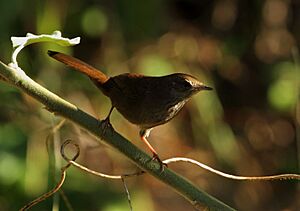Barratt's warbler facts for kids
Quick facts for kids Barratt's warbler |
|
|---|---|
 |
|
| B. b. godfreyi in Pietermaritzburg | |
| Conservation status | |
| Scientific classification | |
| Genus: |
Bradypterus
|
| Species: |
barratti
|
The Barratt's warbler or African scrub warbler (Bradypterus barratti) is a small bird found in parts of southern Africa. It belongs to a group of birds called Old World warblers. You can find it in eastern South Africa, Lesotho, eastern Zimbabwe, and nearby western Mozambique. This warbler loves to live in moist, cool mountain forests.
Contents
About the Barratt's Warbler
The Barratt's warbler was first described in 1876 by a scientist named Sharpe. It was found near the Mac Mac goldfields in South Africa. For a while, some thought it was the same as the Evergreen forest warbler. But scientists later found differences in their calls and how they look. Now, we know there are four slightly different types, or "races," of the Barratt's warbler.
How to Spot a Barratt's Warbler
This bird is about 15 centimeters (6 inches) long. It weighs around 15 grams, which is about as much as three nickels. Both male and female Barratt's warblers look very similar.
Adult birds have chocolate-brown feathers on their backs. Their tails and rumps (the area above the tail) have a reddish-brown tint. Their faces are dark brown, and they have a greyish-buff stripe above their eyes. Their wings are rufous-brown, and their flight feathers are cinnamon-brown.
Underneath, their throats and chins are buffy white. Their throats have dark brown streaks. The middle of their chest and belly is white with grey streaks. Their eyes are usually hazel or dark brown. They have black beaks and dark brown legs and feet.
Young Barratt's warblers have shorter tails. Their upper parts are more olive-colored than adults. Their eye stripes and underparts are yellowish.
The Barratt's warbler can sometimes be confused with the Knysna warbler. They live in similar areas. However, Barratt's warblers have shorter tails and fewer streaks on their undersides. Their songs are also a bit different.
Where Barratt's Warblers Live
The Barratt's warbler lives only in southern Africa. You can find them in patches across the eastern highlands of Zimbabwe. They have also been seen in Mozambique, and in various parts of South Africa like Limpopo Province, KwaZulu-Natal, Lesotho, and the Eastern Cape.
The different types of Barratt's warblers vary slightly in their feather colors and how much streaking they have on their throats.
- B. b. priesti lives in eastern Zimbabwe. It is paler than the other types.
- B. b. barratti is found in northeastern South Africa. It has more grey on its throat and belly.
- B. b. godfreyi lives in southeastern South Africa. It's a bit darker than barratti.
- B. b. cathkinensis is found in the Drakensberg mountains and Lesotho. It's more olive-brown and larger than the other types.
Where They Make Their Home
Barratt's warblers like to live in thick, messy bushes. They can be found among ferns, brambles, and heath plants. They often live near streams, in open areas, or at the edges of forests and tree farms.
Moving Around
Some Barratt's warblers might move away from their breeding spots during the colder winter months. Birds from Zimbabwe might fly east to the lower areas of Mozambique. Those from the Drakensberg mountains might move closer to the coast. They usually move to lower, warmer places for winter.
What They Sound Like
The song of the Barratt's warbler starts with high-pitched "tik, tik, tik..." notes. These notes then get lower and speed up into a fast trill. When they are alarmed, they make a quiet "chrr-chrr" sound.
What They Eat
We don't know a lot about what Barratt's warblers eat. They usually look for food on or near the ground. They move around like a mouse. They are known to eat insects, including crickets.
How They Behave
During the breeding season, male Barratt's warblers sing near their nests. These birds are usually seen alone or in pairs. They stay on or close to the ground. They are very good at climbing through thick plants.
Raising Their Young
Barratt's warblers are monogamous, meaning they have one partner. They build their nests alone and protect their territory. Their nests are made from plant bits, twigs, grass, and leaves. They place their nests on the ground or low down in branches. A typical nest is about 12.9 cm (5 inches) wide.
In Zimbabwe, they lay eggs in October, November, and December. In KwaZulu-Natal, they lay eggs in September and November. In the Eastern Cape, they lay eggs in November. They usually lay two eggs. The eggs are oval-shaped and pinkish-white, with brown and grey spots. We don't know how long the eggs take to hatch. Both parents help feed the baby birds.
Images for kids



